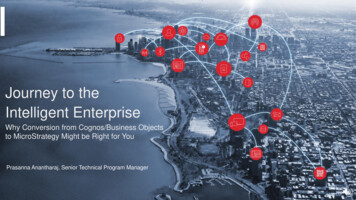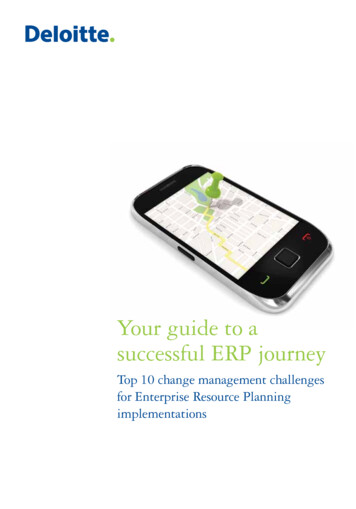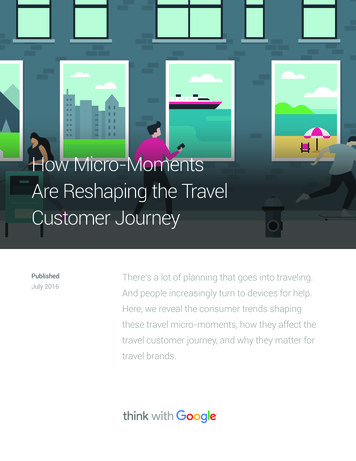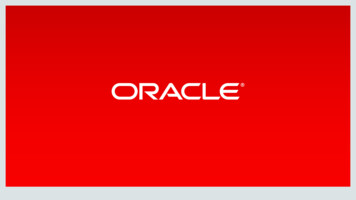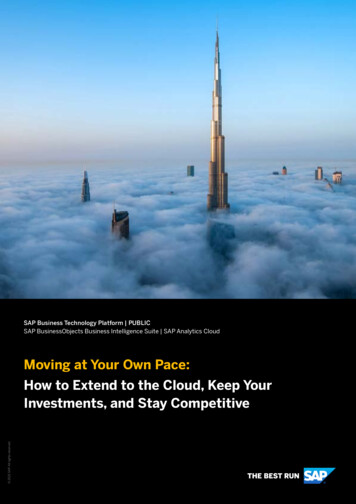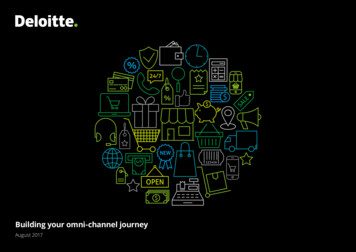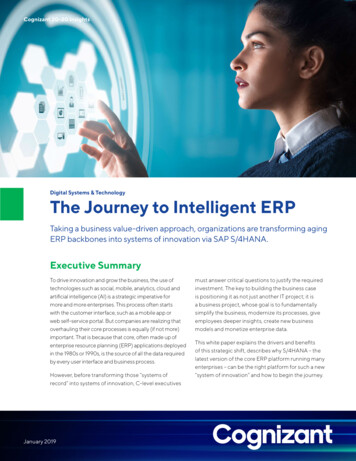
Transcription
Cognizant 20-20 InsightsDigital Systems & TechnologyThe Journey to Intelligent ERPTaking a business value-driven approach, organizations are transforming agingERP backbones into systems of innovation via SAP S/4HANA.Executive SummaryTo drive innovation and grow the business, the use oftechnologies such as social, mobile, analytics, cloud andartificial intelligence (AI) is a strategic imperative formore and more enterprises. This process often startswith the customer interface, such as a mobile app orweb self-service portal. But companies are realizing thatoverhauling their core processes is equally (if not more)important. That is because that core, often made up ofenterprise resource planning (ERP) applications deployedin the 1980s or 1990s, is the source of all the data requiredby every user interface and business process.However, before transforming those “systems ofrecord” into systems of innovation, C-level executivesJanuary 2019must answer critical questions to justify the requiredinvestment. The key to building the business caseis positioning it as not just another IT project; it isa business project, whose goal is to fundamentallysimplify the business, modernize its processes, giveemployees deeper insights, create new businessmodels and monetize enterprise data.This white paper explains the drivers and benefitsof this strategic shift, describes why S/4HANA – thelatest version of the core ERP platform running manyenterprises – can be the right platform for such a new“system of innovation” and how to begin the journey.
Cognizant 20-20 InsightsDigital transformation: Drivers and benefitsThe definition of digital transformation will vary witheach company’s size, its markets, the competitivethreats it faces and its appetite for risk. In our workwith customers, we’ve found a range of goals,ranging from the most conservative to the mostvisionary (see Figure 1).The pragmatists are a relatively smaller numberof organizations that are looking beyond IToptimization. They aim instead to leveragetechnology to increase their operational efficiency,productivity, agility and flexibility while embracingdata to empower real-time decision-making.Conservative organizations take small steps,beginning with optimizing their IT landscapeby moving to S/4HANA. Their key drivers areminimizing the risk, cost and effort of technologymigration and organizational change management.However, their caution could leave them far behindtheir competitors in leveraging digital tools forcompetitive advantage.The visionaries, in our experience, are a verysmall group taking giant steps to become marketleaders. This requires greater investment, a largerappetite for risk and a strong change managementcapability. As a result, successful visionaries willemerge victorious by staying ahead of theircompetitors with new products, services andbusiness models.The business impact of various levels of digital changeData monetizatioBusiness impactnReinventingbusiness modelsVisionariesTransformingbusiness processesReal-time inPragmatistssightSimplifyinguser experieOptimizancetion of ITlandscapeNumber of customers (Representative)Figure 12/The Journey to Intelligent ERPConservatives
Cognizant 20-20 InsightsThe higher the level of business change, thegreater the effort and challenge involved, but themore potential for lasting, substantial competitiveadvantage. For example, optimizing the IT landscapecan enable organizations to meet ongoing needs toreduce costs and increase agility. These needs includesupporting growing numbers of users, transactionsand records, as well as a “cloud-first” strategy thatmakes it easier to leverage new technologies such associal, mobile, analytics, AI and machine learning.Simplifying the user experience addresses theneeds of internal and external users who, in anera of smartphones and app-driven businessmodels, demand a personalized, responsive, andsimple user experience powered by near real-timeinformation on any device. This requires:Other optimization goals include: Reducing software customization that makesit harder to adapt to changes in businessrequirements and increases maintenance costs. Consolidating “islands” of ERP systems toreduce error-prone manual data entry anddelays and simplify business processes whiledelivering more and better real-time insightswith an integrated view of the enterprise. Reducing the data footprint and integratingSAP ERP with other components to cuthardware, software and management costs anddelays in resolving complex system issues. Integrating core ERP processes with opensource technologies to more effectively deliverand analyze data. Speeding time to market and better matchingspending to revenue by shifting from a Cap-Exmodel of owning hardware and software to anOp-Ex, or subscription-based, cloud model.3/ An intuitive, easy-to-use interface. Consistent product, pricing and support informationacross channels such as web, phone and email. Timely and accurate updates on productavailability, pricing and delivery as well as speedyproblem resolution.Real-time insight gives employees and partnersthe right information at the right time to make themost informed decisions. It also provides websitesand other platforms the right content or offersto capture a customer before they click on to acompetitor. The emergence of embedded analyticsthat merge traditional online analytic processing(OLAP) with online transaction processing systems(OLTP) such as ERP enables near real-time insightwithin ERP systems, and the ability to predict andsimulate outcomes using near real-time data.Delivering real-time insight requires: Flexible, high-performance integration of dataamong traditionally siloed systems. Eliminating the time lag between an event andthe notification of all appropriate stakeholders. Access to cloud-based storage and analyticplatforms.The Journey to Intelligent ERP
Cognizant 20-20 InsightsTransforming business processes allows organizations to meettoday’s digital economy requirements of simultaneously cuttingcosts, improving quality and accelerating new product andservice delivery.Transforming business processes allowsorganizations to meet today’s digital economyrequirements of simultaneously cutting costs,improving quality and accelerating new productand service delivery. This involves simplifyingand automating processes that require manual,disjointed effort and eliminating redundant tasksthat drive up costs, slow execution and risk manualerror in tasks such as data entry.Reinventing business models is one of the greatestopportunities created by the advent of digital.It enables an enterprise to tap new markets,customers and revenue before its competitors,creating first-mover advantage and barriers to entry.This requires rethinking the business around theneeds of today’s (and tomorrow’s) customers andtechnologies, and challenging assumptions abouteverything from the organization’s core business to4/what differentiates it from its competitors.This requires: Connecting to people, devices and businessnetworks in real time. Seamless integration with devices on theInternet of Things (IoT). Big data to fuel artificial intelligence (AI)algorithms to understand and act in real time onspecific customer needs and changing market/competitive requirements. Use of the cloud to quickly and cost-effectivelyhandle changing transaction volumes, and tohost core ERP systems for more cost-effectivedelivery of big data, predictive analytics and IoTservices.The Journey to Intelligent ERP
Cognizant 20-20 InsightsData monetization allows enterprises to use theirterabytes of data about everything from customerneeds to manufacturing processes and productreliability for more than “post mortem” reports or (atbest) demand forecasting. Migrating such data to amodern ERP platform (and integrating it with datafrom the IoT) allows such data to be processed withpredictive analytics and AI platforms to unlock itsfull value. This value can take the form of predictivemaintenance and inventory optimization to reducecosts or better understand customer behavior toincrease sales. The cloud also allows use of the datain new business models, such as selling it (whereappropriate) to partners who can profit from anunderstanding of customer needs or the status ofproduct or equipment.Data monetization requires: Storing, accessing and applying mathematicalmodels to very large volumes of data quicklyenough to deliver near real-time analytics. Integration with open-source or proprietaryadvanced analytics and machine learning toolssuch as the Python programming language andSAP Leonardo machine learning platform. Semantic tools to help understand andcategorize the data. Strategic planning and business consulting toidentify and fill market needs, Proper security, regulatory and complianceprocesses. Self-service portals that allow users to easilyaccess data and insights. An organization’sdigital overhaul begins with a thorough selfassessment of the extent to which it is usingdigital to meet its business goals, and how itcould improve. These organizational prioritiesand the urgency with which an organizationmust move are typically driven by thecompetition, the organization’s ability to fundbusiness innovation, its risk appetite, its currentIT infrastructure and the skills of its staff.Building a modern digital foundationWith SAP S/4HANA, organizations can modernizecore back-end “systems of record” into agile“systems of innovation” that can quickly adaptto changes in technology, markets, customerneeds and business models. This can be achievedthrough the seamless integration of SAP S/4HANAin-memory database, which speeds analyticprocessing, with open-source applications such asHadoop, Python and R. (See “Quick Take.”)The ability to build extensions on the SAPCloud Platform integrated with the S/4HANAcore allows businesses to, for example, simplify5/customer billing, reveal hidden trends in financialstatements and shorten the invoice-to-cashprocess. Integration with SAP Leonardo empowersbusinesses to complement core processes withrobotic process automation, artificial intelligenceand machine learning.Together, the elements of the SAP S/4HANAecosystem (See Figure 2) provide transformativeprocess automation, simplification that deliversease of use, real-time information and integration,and a seamless data flow with other systems.The Journey to Intelligent ERP
Cognizant 20-20 InsightsQuick TakeTapping open-sourceintegration to cut productionplanning costsS/4HANA offers a library of whitelisted APIs that can be seamlessly integrated with opensource platforms such as the TensorFlow machine-learning framework and the Pythonprogramming language. These APIs let organizations pull data from core ERP processes,apply machine learning and analytical algorithms to them, and return data, decisions ortasks to the execution system.This can help manufacturers build intelligent solutions such as robotic process automation,predictive modeling to enable predictive maintenance, intelligent scheduling andoptimization logic for efficient capacity planning.For example, our Production Planner’s Assistant is a voice-enabled chatbot poweredby conversational AI. Based on voice instruction from a production planner, the chatbotextracts production order data from S/4HANA, identifies exceptions that require humandecisions and releases all other orders for a selected period to the shop floor based onpredefined rules. Based on our tests using sample customer data, such automationeliminates as much as 60% of the manual work associated with production planning.This assistant also uses machine learning to simplify and automate decision-making. It can,for example, learn when a shortage of raw material of production capacity should trigger acancellation of a customer order and improve such decision-making over time.6/The Journey to Intelligent ERP
Cognizant 20-20 InsightsQuick TakeHow SAP S/4HANA facilitates digital businessOptimizing the ITlandscapeData footprint reduction, improved performance and scalability,added functions through open-source support, cloud-basedservices.Simplifying theuser experienceIntuitive, user-friendly Fiori interface provides anywhere,anytime access to information. In recent versions, SAP startedintroducing intelligent process automation powered bymachine learning.Real-time insightEmbedded analytics for real-time display of metrics such asKPIs, exceptions and alerts. Transactions and real-time alerts onthe same screen enable faster response.Transformingbusiness processesDeduplication of processes for improved consistency andproductivity. Real-time information through rapid consolidationof transaction data and master data reduces costs and delays.Reinventingbusiness modelsIntegration with SAP’s machine learning/artificial intelligenceplatform enables robotic process automation and delivery ofnew services. Deployment in the cloud as well as on-premisedata centers enables businesses to move from Cap-Ex toOp-Ex procurement models and respond more quickly tochanging needs.DatamonetizationIntegrated add-ons to S/4HANA core enable innovation.Integration with the cloud and open-source technologiescreate new opportunities for data analytics.7/The Journey to Intelligent ERP
Cognizant 20-20 InsightsQuick TakeThe evolving digital CSoHS/4HANA 1511S/4HANA 1610 S/4HANA 1709S/4HANA 1809Baseline ERP processesBusiness model re-innovationOptimization of IT landscapeBusiness process transformationData footprint reductionReal-time insightPerfomance improvementData monetization opportunitySimplifying experienceNotes: SAP S/4HANA is also cloud enabled and has cloud versions.This diagram is relative only and does not indicate any percentage improvement.Figure 2Source : Cognizant8/The Journey to Intelligent ERP
Cognizant 20-20 InsightsMaximizing the returnsOur experience shows that companies looking toadopt S/4HANA face four common challenges: Inertia and organizational resistance oftenleading to simply “copy and paste” legacyprocesses from SAP ERP Central Component(ECC), the previous generation of SAP’s ERPsoftware, into S/4HANA. As a result, theymiss opportunities for greater efficiency andproductivity by redesigning business processesleveraging the innovations of S/4HANA.Thinking of S/4HANA as simply SAP ECCwith the addition of the Fiori user interface.This means they forego benefits such as realtime analytics and new process innovations suchas demand-driven MRP or central finance.At the other extreme, treating the moveto S/4HANA as a “from scratch” new ERPimplementation, rather than leveragingthe S/4HANA best practices libraryand SAP Model Companies or similarpreconfigured industry solutions providedby SAP’s implementation partners. This9/incurs unnecessary cost and effort, whichcan be substantial based on the complexityof the customer environment, the number ofinstances they run, and the scope of languages,geographies and business processes involved. Underestimating the impact of changemanagement and training requirements.Even existing ECC customers are facingchallenges in convincing their business processowners to adopt S/4HANA innovations andmove to standard processes rather than highlycustomized legacy ECC systems.How can companies avoid these pitfalls? Frommore than 100 S/4HANA engagements, we haveidentified the three proactive steps that helpmaximize returns from S/4HANA investments: Start the journey with a value discoveryassessment. Leverage S/4HANA industry best-practicedriven design. Invest in change management and training.The Journey to Intelligent ERP
Cognizant 20-20 InsightsQuick TakeReinventing business modelsWe are helping an automotive manufacturer move beyond traditional vehicle sales to asubscription model in which the customer will pay a monthly fee for not only the vehiclebut also all the related services. We are developing a digital solution that will enableevery aspect of this service—from analyzing the customer’s credit using big data-basedpredictive analytics, tracking the vehicle through sensor data, providing service through anationwide network of maintenance facilities, and maintaining (using predictive analytics)an optimal parts inventory at each location to meet service-level expectations whileminimizing costs.Analysts predict that such subscription programs could account for nearly ten percent ofnew vehicle revenue in the U.S. and Europe by 2025. This new business model will help themanufacturer tap this new sales channel.Transforming businessprocessesThe use of manual scheduling at a European manufacturer caused significant downtimeand inefficient utilization of molding and pressing equipment. We are helping thismanufacturer reinvent shop floor scheduling using the S/4HANA core to integrateadvanced optimization techniques into scheduling. This is expected to produce a doubledigit increase in the utilization of mold and pressing equipment through a significantreduction in downtime and increased productivity.This will reduce costs, increase manufacturing efficiency, and improve productivity andcustomer service through the on-time delivery of products.10/The Journey to Intelligent ERP
Cognizant 20-20 InsightsThe value discovery assessmentThis helps customers achieve maximum value fromtheir S/4HANA implementations by evaluatingthe impact, opportunities, risks and return oninvestment before committing to S/4HANA. Italso helps CIOs build the business case for it withbusiness stakeholders and senior management.For example, our approach to value discoveryconsists of three steps:1. A technical impact analysis uses multiplediagnostic tools to understand the impact ofS/4HANA simplification on the SAP transactioncodes currently in use in the organization,the roles that give users secure access to thesystem, and integration between their currentSAP platform and other business systems. Thiscontext helps clarify the cost and effort requiredto move to S/4HANA.11/2. A business process analysis identifies businesschallenges the organization is facing and howthe new functions within S/4HANA can helpaddress these issues. Together with a broaderanalysis of the competitive landscape andexternal industry forces, this step helps identifythe potential benefits of a move to S/4HANA.3. The results of the first two stages arecombined in an assessment that includesan impact analysis, business case with ROIestimates, high impact use cases and a roadmapfor the S/4HANA implementation.This process helps customers build a businesscase for the benefits of S/4HANA, understandtheir organizational readiness for it, and creates animplementation roadmap complete with estimatesof the required effort and key performanceindicators to help management track the process.The Journey to Intelligent ERP
Cognizant 20-20 InsightsIndustry best practice-driven designRather than “reinventing the wheel” by configuringevery business process in S/4HANA, businessescan reduce implementation cost and effort usingthe SAP S/4HANA best practices library. Thisconsists of process documentation, preconfiguredbusiness processes and statutory processes formore than 20 countries and other accelerators.In addition, SAP’s Activate methodology is amodular and agile framework that helps customerstake such a best practices-driven approach toimplementation of, or migration to, S/4HANA.Note: SAP S/4HANA best practices are genericin nature. To address this gap, leading integrationservice providers are enhancing SAP’s bestpractices with industry-specific S/4HANAsolutions. (See Figure 3 for an overview of oursolutions in use at various clients worldwide.)Cognizant’s industry-specific S/4HANA Pre-configured templates speed transition to SAP S/4HANA Utilities orSAP Customer Relationship and Billing.ChemicalsChemXpressIncludes embedded SAP Country best practices, as well as process flowdiagrams, test scripts, templates
Hadoop, Python and R. (See “Quick Take.”) The ability to build extensions on the SAP Cloud Platform integrated with the S/4HANA core allows businesses to, for example, simplify customer billing, reveal hidden trends in nancial statements and shorten the invoice-to-cash process. Integra

